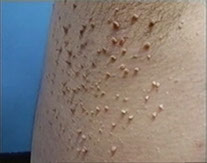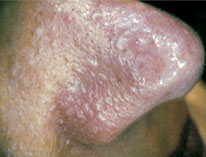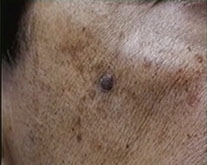Skin Tag Removal
Important information
Skin Tag Important Information – Did you know Most skin irregularities are considered moles? Identifying what type of mole you have can be difficult for most people. However, our professional staff at Body Beautiful can help identify and remove your skin abnormalities.
| Types of Skin Irregularities: | Skin Tag Important Information |
 | Skin Tags- Very common skin growth. A skin tag is a small narrow stalk that protrudes from the skin. They are normally the same color as the skin or a bit darker. Skin tags are typically found on older people and can be caused by genetics, weight gain or pregnancy. They can be found in areas where garments or jewelry rub, such as the neck, underarms, bra line, inner thighs or eyelids. |
 | Acne pimples- Red bumps with white heads that consist of oils trapped under the skin, forming acne pimples commonly found on teens or adults with Rosacea. |
 | Broken Capillaries- Blood vessels that are blue or purple and can be found on the face, under nose, shoulders, legs, and feet. Spider veins can develop as a side effect of blood thinners, repeated trauma to the area, genetics, weight gain or pregnancy. Broken Capillaries are harmless unless you have Varicose Veins as well. Spider veins can reappear or form a new one, but you may treat them if they continue to return. |
 | Cherry Angiomas- Small or large red dots, also known as Campbell de Morgan spots, are usually found in adults above 30. These are caused by genetics, and, if you have one, you will continue to develop more. Cherry Angiomas are mostly on the core of the body, arms, and legs. |
 | Cholesterol deposits (Xanthoma) -These appear on the face, under or around the eyes, and on arms and legs. They’re white or yellowish small bumps of cholesterol deposits. They can be a sign that blood fat levels are too high. |
 | Fibromas- Can be hard or soft. These are a type of benign tumors such as “keloid scars” or “skin tags.” Fibromas appear on the face or on the body. |
 | Milia- A firm cyst filled with keratin that appears as small, white, hard bumps on the face. Commonly found around the eyes, they cannot be popped or squeezed. One theory for why this happens is due to overuse of leaving makeup on overnight or using improper much lotions. |
The Solution: Lamprobe
The Lamprobe is used to remove small benign cosmetic irregularities on the skin, such as whiteheads, Milla, blackheads (comedones) pigmented epidermal growths (fibromas), broken capillaries, pimples or pustules, blood spots and skin tags that are prevalent on the neck, face, arms, legs, stomach, back and décolleté area. Lamprobe operates on the source of fluids being drawn to heat energy, which is released by various probes. Treatments usually take 15-20 minutes.
Most Common Irregularities | Skin Tag Important Information
Skin Tags
Skin tags, also known as Acrochordons or fibrous polyps, are small flesh colored pouches that can either be raised on the skin or protrude from the skin on a stalk termed “peduncle.” They’re created of loosely ordered collagen fibers, blood capillaries enclosed by a thickened or thinned epidermis.
Skin tags may be either smooth or irregular. Although colors normally resemble your skin tone, they can occasionally produce a deeper pigmentation like a mole. They can be found singly or in multiples. Skin tags are tiny, grow gradually, and they should never get to be larger than approximately 1.30 cm in dimension. They can be a small flap of skin or around a bump that is attached to your body by a stalk.
What causes skin tags?
Skin tags are more common in middle-aged women than men or children. However, both men and women are susceptible to skin tags as they age and they are quite common in those over 60 years of age. They can occur after pregnancy or weight gain. They’re similarly more inclined to be seen in overweight or obese people as well as people with Type 2 diabetes. A tendency to develop skin tags may run in families and in some cases, infants may be born with them.
Skin tags are most likely found where the skin may crease, such as around the neck, underarms, groin, under the breasts, inside of the upper thigh area, or on the eyelids or cheeks.
Why get them removed?
Although skin tags are benign, there is a number of reasons why you may want them removed. They may be rubbed and irritated by clothing, jewelry, etc. which may cause some pain and inflammation of the area; and of course, cosmetic reasons.
Moles & Angiomas
These should be the same color as your skin or a bit darker and should be soft to the touch. Moles and Angiomas can be easily removed by our Lamprobe. You may want to visit your doctor if you have something that doesn’t match this description.
Cherry angiomas
These are clusters of capillaries at the surface of the skin, forming a small round dome, papule. They range in color from bright red, purple or brown. If they develop sometimes only one-tenth of a millimeter in diameter, relatively flat, and seeming as little red dots or spots. However, they then usually grow in diameter. As they grow larger, they tend to expand in thickness and may take on the raised and rounded dome shape. Cherry angiomas may bleed profusely if they are picked at or scraped.
Skin Tags important information | Lamprobe Treats
- Broken Capillaries
- Brown Raised Moles
- Spider Naevi
- Whiteheads
- Blackheads
- Moles
- Milia
- Fibromas
- Skin Tags
- Brown spots
- Acne Pimples
- Cheery Angiomas
- Cholesterol Deposits
Causes
Heredity may be the biggest factor. Cherry angiomas appear spontaneously for many middle-aged people, but can also occur in an aggressive eruptive manner in any age. The underlying cause for the development is not understood, much because of a lack of interest in the subject.
Present findings suggest that hemangioma may occur through two different mechanisms: angiogenesis (the formation of new blood) and vasculogenesis (the formation of new veins).
Most patients have an increase in the amount and size of cherry angiomas with age. They’re harmless except during very unusual circumstances or cases which include an abrupt appearance of various angiomas, that can be a warning of a developing an internal malignancy.
If they are cosmetically unappealing or are subject to bleeding, angiomas may be removed, but this may cause scarring
Client Aftercare









